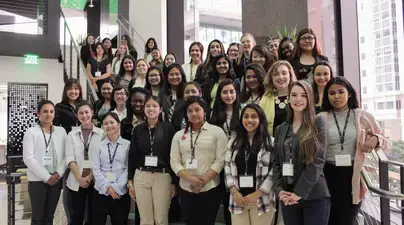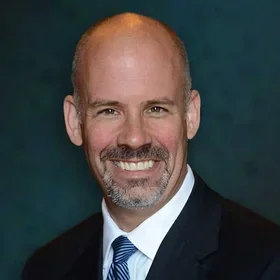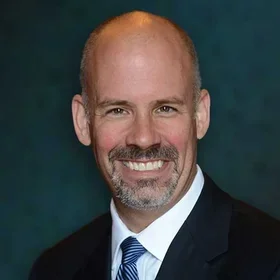As a kid growing up in Iowa, Melinda Anderson enjoyed math and science, yet she never planned on a career in STEM (science, technology, engineering, and mathematics).
“Computer science never crossed my mind while in school,” Anderson recalled. So, when the ministry & biblical studies major ended up at Microsoft, no one was more surprised than her.
As a Community Engagement Manager for the Redmond, Washington-based technology company, Anderson works to encourage girls and other underrepresented student groups to imagine themselves in the tech industry. Microsoft’s philanthropic commitment includes supporting programs like the Girls in STEM Initiative at Columbia’s School of Professional Studies.
Now in its fifth year, Girls in STEM aims to close the persistent gender gap across STEM fields by preparing students from underrepresented populations to enter college and a job economy in the throws of widespread digital transformation.
In the conversation edited for length below, Anderson reflects on her five years coordinating the Microsoft partnership.
How would you describe your own STEM journey growing up?
Oddly, I’ve never been asked that before in all the work that I do! My mom was a nurse for over 40 years. She was the only person in my family who had a degree like that, and I knew that she was a little bit different from other moms in my circle in that she had this very professional and — in my mind — very important job.
But I didn’t associate that to STEM or science careers as a child; I was on a totally different trajectory. I went to college thinking I would do elementary education and then switched to cross-cultural ministry. I did internships in places like World Relief MN, with a mission organization in Kenya and things that were not related to technology at all. I started at Microsoft as a temp and then in an administration role. This community operations role opened after a few years with the sales team. What felt like a fluke at first turned out to be a huge blessing.
In many ways, I’ve learned along with the students in the program. As I’ve grown at Microsoft, so has my STEM journey.
I love the second half of the week, when [the students] are not nervous anymore — by Day 3 they act like they own the place. They’re bounding in saying, 'I belong here.'
— Melinda Anderson, Community Engagement Manager, Microsoft
How did you become involved with Girls in STEM?
Part of my role is community engagement and outreach, so at the time this started, I was the point person for our region handling grants and activities with schools, nonprofits and other external community partners. When the program consultants approached Microsoft about participating in Girls in STEM, I found that the program aligned really well with our goals around digital skills for young people. From our YouthSpark program that we ran for a number of years to our Microsoft Technology Education and Literacy in Schools, or TEALS, program, we’ve always been about equipping young people with the skills they’ll need for 21st-century jobs and creating access for students who are underrepresented in tech.
What has the experience been like over the five years you’ve worked with the program? Any favorite moments?
The program has been remarkably consistent over the years—it’s the same format of one week of intense 8 a.m. to 5 p.m. days. I’ve appreciated that consistency from year to year. Each year we learn something new to enhance the future programs.
I appreciate the commitment from the SPS side to understanding what the students need, what they are ready for and how to create content that meets them where they’re at and helps them to succeed. There’s a commitment to empowering the students, to challenging them and keeping it at a rigor that aligns with Columbia.
We’ve added components in the last four years, like the Dress for Success visit helping with business attire, a parent orientation so that the families understand what’s happening and a “Rock Your LinkedIn Profile” workshop. We’re also looking to include women from the companies we work with at Microsoft, like the speaker from Tesla who joined last year and really connected with the students.
I always love the Mentoring Day, where students are paired with an employee mentor and challenged to use technology to solve a problem and then pitch that idea. You not only see the visible diversity amongst the group, but how people approach solving a similar problem and each do it differently, that’s really fun to see. The students come up with fascinating ideas!
Generally, I enjoy the second half of the week, when the students come in each morning and they’re excited to be there. They’re not nervous anymore — by Day 3 they act like they own the place! They’re bounding in saying, “I belong here.”
I appreciate the commitment from the School of Professional Studies to understanding what the students need, what they are ready for and how to create content that meets them where they’re at and helps them to succeed.
— Melinda Anderson, Community Engagement Manager, Microsoft
How do you see participants interacting with Microsoft?
I’ve found a lot of kids don’t always know what we do. They might know us as the company that created Office, which they’ve used in school, but they may not necessarily know that Xbox is part of Microsoft, so it’s kind of mindblowing for them to understand that gaming and productivity can be part of the same company.
Our employees love connecting with the students serving as mentors. I think it helps the students understand who we are as a company, why we have a presence in the Bay Area, how many opportunities there are within a big company like Microsoft—and that many of those are not necessarily technical roles. They can see that you can be a successful person in technology without being a person who only writes code.
Again, it’s about the digital skills piece and how we equip students for the future. We don’t know what those jobs are going to be. But we know that society is changing — Microsoft is part of that digital transformation — and we need to help students understand things like AI and how ubiquitously technology is used in our society.

How would you advise an organization that’s interested in setting up a similar program?
It’s kind of a chicken-and-egg situation: we need more instructors who reflect the diversity of the students, but we won’t have that unless we invest in programs like the Columbia camp. We need to keep increasing the diversity of the industry in general. So, it’s important for organizations to invest in leaders who reflect the students.
It’s also important to provide a safe space so the students don’t feel intimidated. I was scared when I came to work at Microsoft — and I was a full-grown adult! I didn’t have a technical background and felt like I didn’t belong. Turns out I have a really Type A personality and fit in well!
At the same time, you can’t dumb it down. These students are smart. They have access to information if they want it. You need to figure out where your students are and make sure you present material that’s challenging enough but not too discouraging. It’s really finding that sweet spot, which you may have to adjust while getting to know your students throughout the week.
I’m passionate about what I do, and I care about the students. We need exposure and opportunities that excite students, but we need to create things that go deep and for the long haul. Opportunities like a five day camp create a more intense learning experience while also allowing students who are not yet committed a shorter chance to try it out.
Any advice for girls who might want to work at Microsoft or pursue a STEM career?
Take advantage of the free opportunities to learn. Ask questions. Be curious. Try things. Fail. Try again. Resilience and grit—they’re buzzwords, but they’re so important, especially in a highly competitive market.
I would also encourage students to support each other and build community, regardless of whatever group they might be part of. Don’t see it as a competition for limited resources. Work together. Hold each other up. Seek allies who want to support and stay connected. Be bold!

